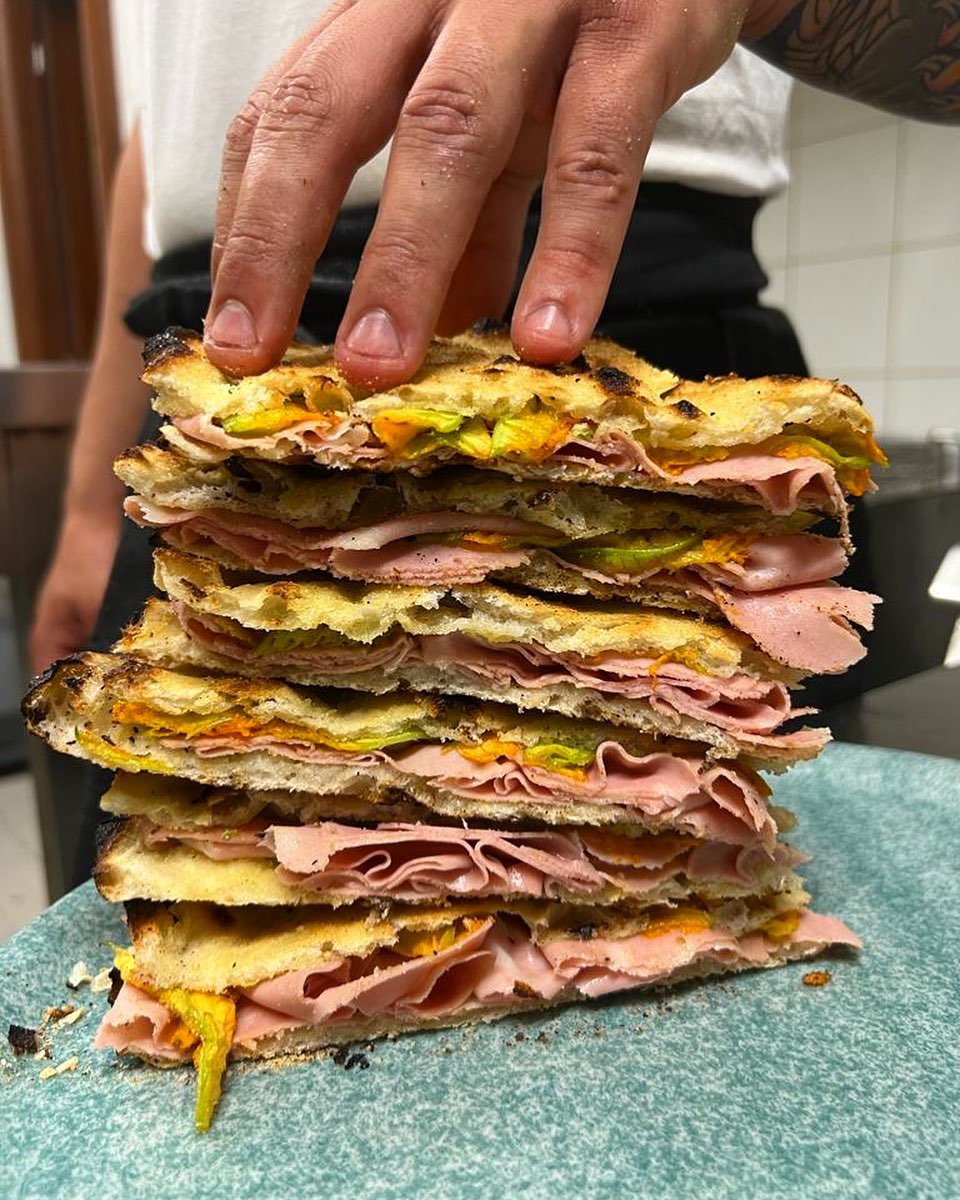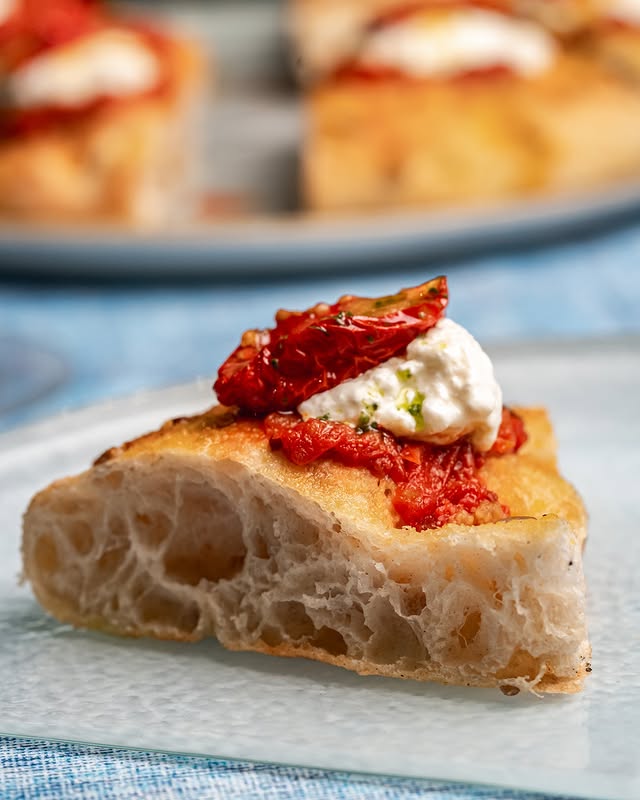You may have noticed the culinary craze that’s been popping up in supermarket aisles and on restaurant menus from Milan to Stockholm to LA: it sounds like pizza, looks like pizza, but swears it’s not pizza. Its name is pinsa, and it can be considered pizza’s ambitious younger cousin.
By appearances, you’d be forgiven for confusing the two. Pinsa is a long oval or rectangle of dough that’s fired up at high temps, topped with all sorts of goodies, and served in slices—much like pizza al taglio. But take a bite and you’ll realize that its dough is notably puffier and crispier, with toppings that lean fresher and brighter than those of its counterparts. Because of this, it’s been slyly marketed as a “lighter” alternative to pizza that dates back to Ancient Rome—except… it doesn’t.
Though there’s practically a pinsa joint for every pizza spot in the Eternal City, if you asked any Roman 20 years ago where to find some, they’d look at you like you mispronounced the other popular dish. The name comes from the Latin word pinsere (to press), and some cite a passage from Virgil’s Aeneid—Aeneas’s feast in Latium includes a rustic flatbread—as pinsa’s earliest reference. But the bread’s more accepted origin story tells of an original, focaccia-like recipe that dates back to Roman times. In this well-crafted tale, peasants supposedly mixed water, cereals, salt, and aromatic herbs to form a soft dough that they cooked on the grill.
However, the real story is a little less 1st century BC and a lot more modern. In 2001—the same year that Apple gifted us the iPod and Genova hosted the world’s least chill G8 summit—Roman baker Corrado Di Marco broke the news. He admitted that the pinsa recipe was not ancient, nor even some peasant dish. It was his own creation, a dough of wheat, rice, and soy flours and a fermented starter called biga that’s easier to digest. Wheat gave structure, rice kept it moist, and soy added crispness without greasiness; the 72-hour fermentation made it airier and more flavorful. His pitch of “40% less fat! 20% fewer calories! 15% less sugar!” was catchy, and the “ancient” backstory sealed the deal—pinsa became a trend.
Even after this revelation, pinsa has retained its place in the limelight. Both in the Eternal City and abroad, you’ll find it handed to hungry schoolkids and suited adults alike at lunchtime, served alongside bottles of wine at enotecas, and boxed up for to-go orders to be enjoyed in front of a movie at home. It comes topped with everything from mozzarella, burrata, stracciatella, tomatoes (fresh and sauce), prosciutto, bresaola, and arugula to fancier options like smoked salmon or truffle oil; though you can best appreciate the stuff by ordering the bianca, plain with just olive oil, salt flakes, and occasionally fresh greens. Pinsa’s story—pure marketing genius—is what historians Eric Hobsbawm and Terence Ranger would have called an “invention of tradition”.
But in some ways, it’s like the city of Rome itself, proof that both old and new can coexist, that innovation can happen without discrediting the past. And, in a country that all-too-often rests on its laurels, pinsa took off simply because it’s really, really good.

Pinsa with mortadella, fiori di zucca, and olio al limone; Courtesy of @nuvole.di.farina
Where to Eat the Best Pinsa in Rome
You can find pinsa just about everywhere in Rome and abroad—ready-made bases at the supermarket, quick takeout spots, and sit-down restaurants serving it hot and fresh. Here are the best places in Rome to eat it.
La Pratolina — Back in 2001, this was one of few places in Rome dishing out pinsa. Named after the neighborhood it’s located in, Prati, this spot became the epicenter of the pinsa movement, helping to spread its popularity long before it was a citywide staple. Their menu is an ode to Roman flavors, and don’t miss their seasonal special with puntarelle and anchovies.
Il Ponticello — The place where four hip young cousins decided to bring together their two great passions: pinsa and craft beer. Opened in 2015, their kitchen whips up custom dough and layers it with seasonal flavors. The “scialla” —topped with chickpea purée, buffalo mozzarella, and garlicky chicory—is a vegetarian’s fever dream.
Pinsere — In the Sallustiano district near Piazza della Repubblica is this cozy laidback spot, where the scent of baking dough and bubbling cheese fills the air. Order the pinsa bianca—confusingly topped with potatoes, speck, and provola—and thank me later.
Loro — Located between Tor de Cenci and Spinaceto, here, pinsa is exactly as it should be: crisp, airy, and light, with toppings that hit the perfect balance between indulgent and fresh. Their signature pinsa is topped with mozzarella cheese, sautéed chicory, cherry tomatoes, and grated pecorino, and it doesn’t need anything extra.
Locanda Nocera — A little off the beaten path in the heart of the Appia Antica Park and sharing space with a tennis club, this modern trattoria opened mid-pandemic, but quickly became a local favorite. Don’t miss the “sapori del sole”, with ’nduja, stracciatella, and cherry tomatoes.
Nuvole di Farina — In the Torrino district, they serve up a pinsa with radicchio, gorgonzola, and walnuts. The rich, tangy bite of blue cheese, the slight bitterness of radicchio, and the nutty crunch of walnuts come together in a way that proves pinsa isn’t just a lighter alternative to pizza.
